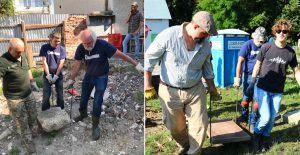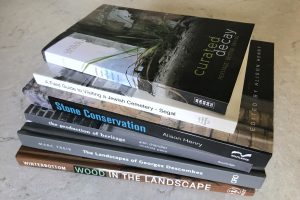![]() Ця сторінка також доступна українською.
Ця сторінка також доступна українською.
Introduction
Although much of the guidance on this website is derived from hands-on experience on Jewish cemetery preservation projects by individual activists and civil society organizations in western Ukraine, a significant portion of the material has been supplemented by information provided by academic and professional experts, both in person and from print and electronic books, articles, and videos. Often, an answer is available to questions which arise while planning or conducting heritage projects, whether the questions are about concepts, methods, materials, or tools. In many cases, examples from different but parallel research and application fields can provide solutions to problems in regional Jewish burial grounds.
Regional and International Experts

Expert guidance offered by professors of architecture and stone conservation at Lviv Polytechnic. Photos © RJH.
A number of experts, both in western Ukraine and elsewhere, have provided direction and important advice for approaching and conducting Jewish cemetery projects in the region. While their information has been incorporated into the guide section of this website, the resources at these institutions are both broader and deeper than what has been captured here; other activists may benefit from further research and joint efforts with these experts. Listed on the page are the universities and other educational institutions, government offices and programs, NGOs and other non-commercial organizations, and professional and commercial organizations which have published or contributed materials used in developing this website.
See the page on regional and international experts.
Print and Electronic References

Two stills from an NCPTT video teaching methods for cleaning stone grave markers.
Images © US Department of the Interior NPS.
Some cemetery project skills and knowledge can only be learned by doing, while engaged with one’s own hands in a project; for these skills, time spent in an internship role under the guidance of a recognized expert is the fastest way to gain awareness and capability. However, much of the knowledge needed to develop cemetery projects can be learned through research, study, and experimentation. Even where project leaders cannot do any of the specialist design or implementation work themselves, learning the terminology as well as key issues and solutions will help overall project concepts and tracking, and minimize miscommunication with contractors.
A large number of print and electronic references are provided in bibliographic format on the pages linked below; this list is in the same topical sequence as the themes of the guide section. The overview page outlines the types of references listed and linked to this website. The overview also includes a separate annotated and linked list of significant internet resources with strong technical expertise in many aspects of cemetery preservation, to enable further research.
Note that each reference book, article, etc. is listed only once on these pages, so it will often be useful to review the references on related topic pages; this is especially true for the project concept page. On each of the pages, a small number of key references are highlighted and summarized as especially useful in heritage work in western Ukraine. Although the cost of academic texts can be quite high, activists with access to academic libraries may find many of those books available for review and study onsite (for example, the outstanding library at Lviv’s Center for Urban History of East Central Europe holds dozens of the texts listed on these pages), and many of the listed references are available for free or at low cost online and from university, NGO and government sources.
Site Clearing, Cleaning, and Reconditioning
Landscape Planning, Development, and Care
Stone Conservation, Documentation, and Care
Memorial Design, Development, and Care
Directional and Information Signage

Using self-made lifting hooks to move displaced Jewish headstones in Rohatyn and Lviv. Photos © RJH.
Technical Tools, Methods, and Data
Rounding out the resources in this section of the website, a small number of pages are intended to bridge theory and practice where no simple and regionally-relevant guidance is otherwise available. Typically this means suggestions and tips for selecting and applying the specific tools which are most useful for Jewish cemetery research, design, rehabilitation, and construction projects. In some cases, it means creating unique tools and methods to manage aspects of the work where conventional tools are not helpful. Also included here are excerpts from materials data tables which are relevant and useful in planning and designing landscapes, memorials, and more.
See the overview to the supplemental technical section of this website.

